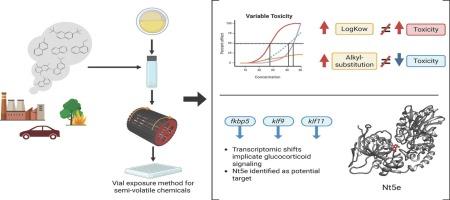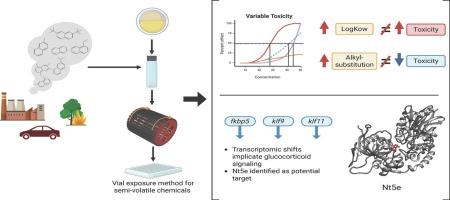化学结构驱动烷基取代萘对斑马鱼的发育毒性
IF 9.7
1区 环境科学与生态学
Q1 ENVIRONMENTAL SCIENCES
引用次数: 0
摘要
萘及其烷基取代衍生物是环境和人体暴露研究中最丰富的多环芳烃(PAHs)之一,但由于测试半挥发性化合物的挑战,它们的发育毒性和作用方式仍然知之甚少。本研究开发了一种基于小瓶的、高通量的方法来有效地评估萘和一组24烷基取代萘的活性。将早期生命阶段的斑马鱼暴露在旋转密封玻璃小瓶中的每种化学物质的浓度系列(0-50 µM)中,以尽量减少挥发。计算形态学终点的基准浓度(BMC50)值,确定行为效应的最低效应水平。使用选定化学品的身体负荷测量和logKow模型对数据进行了评估,以确定麻醉作用模式的证据。在单一浓度和时间点进行靶向转录组学以及硅分子对接,以产生作用模式假设。小瓶法可以检测高度可变的发育毒性,而以前使用标准96孔板暴露是观察不到的。体温和身体负荷是毒性的较差预测指标,提示非麻醉作用模式。转录组学分析揭示了糖皮质激素信号通路中断的证据。分子对接发现了可能介导观察到的效应的潜在蛋白靶点(如CYP1A2、NT5E、FOLR1)。本研究表明了适宜的半挥发性化合物暴露方法的重要性,揭示了烷基取代萘的结构依赖性毒性,为进一步研究烷基取代萘的机理和改进风险评估奠定了基础。本文章由计算机程序翻译,如有差异,请以英文原文为准。


Chemical structure drives developmental toxicity of alkyl-substituted naphthalenes in zebrafish
Naphthalene and its alkyl-substituted derivatives are among the most abundant polycyclic aromatic hydrocarbons (PAHs) in environmental and human exposure studies, yet their developmental toxicity and mode of action remain poorly understood due to challenges in testing semi-volatile compounds. This study developed a vial based, high throughput method to effectively assess the activity of naphthalenes and a set of 24 alkyl-substituted naphthalenes. Early life stage zebrafish were exposed to a concentration series of each chemical (0–50 µM) in rotating sealed glass vials to minimize volatilization. Benchmark concentration (BMC50) values were calculated for morphological endpoints and lowest effect levels were determined for behavioral effects. The data were assessed for evidence of a narcotic mode of action using body burden measurements for select chemicals and logKow modeling. Targeted transcriptomics at a single concentration and timepoint as well as in silico molecular docking were conducted to generate mode of action hypotheses. The vial method enabled detection of highly variable developmental toxicity not previously observed using standard 96-well plate exposures. LogKow and body burden were poor predictors of toxicity, suggesting a non-narcotic mode of action. Transcriptomic analysis revealed evidence for the disruption of glucocorticoid signaling pathways. Molecular docking identified potential protein targets (e.g., CYP1A2, NT5E, FOLR1) that may mediate observed effects. This study demonstrates the importance of appropriate exposure methods for semi-volatile compounds, reveals structure-dependent toxicity among alkyl-substituted naphthalenes, and provides a foundation for further mechanistic studies and improved risk assessment of alkyl-substituted PAHs.
求助全文
通过发布文献求助,成功后即可免费获取论文全文。
去求助
来源期刊

Environment International
环境科学-环境科学
CiteScore
21.90
自引率
3.40%
发文量
734
审稿时长
2.8 months
期刊介绍:
Environmental Health publishes manuscripts focusing on critical aspects of environmental and occupational medicine, including studies in toxicology and epidemiology, to illuminate the human health implications of exposure to environmental hazards. The journal adopts an open-access model and practices open peer review.
It caters to scientists and practitioners across all environmental science domains, directly or indirectly impacting human health and well-being. With a commitment to enhancing the prevention of environmentally-related health risks, Environmental Health serves as a public health journal for the community and scientists engaged in matters of public health significance concerning the environment.
 求助内容:
求助内容: 应助结果提醒方式:
应助结果提醒方式:


